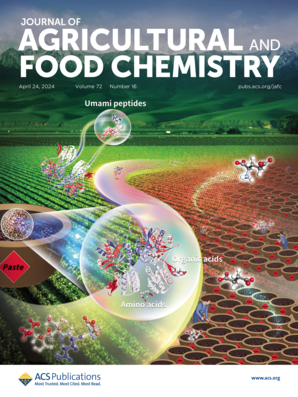吡虫啉及其代谢物在蛋鸡体内的时间分布:对食品安全潜在影响的评价
IF 6.2
1区 农林科学
Q1 AGRICULTURE, MULTIDISCIPLINARY
引用次数: 0
摘要
吡虫啉(IMI)在美国被广泛用于家禽养殖场,以控制黑甲虫。然而,关于急性暴露于亚临床浓度的家禽产品中IMI及其代谢物的持久性和分布的知识有限。在本研究中,成熟母鸡分别给予吡虫啉(安慰剂、1mg /kg、10mg /kg)剂量,采用液相色谱-串联质谱法定量组织中IMI及其代谢物。血浆IMI在24 h (1 mg/kg)和48 h (10 mg/kg)内均低于定量限。在10 mg/kg时,IMI当量(IMI及其代谢物的总和)在24小时后超过了美国联邦法规对胸肌和大腿肌肉、脑、肝脏、脾脏、肾脏、脂肪和鸡蛋设定的监管阈值。在1 mg/kg时,IMI当量在24小时后超过了肝脏、脾脏和鸡蛋的阈值。这些结果表明,低剂量暴露于IMI可能导致供人类食用的家禽产品违反联邦法规。本文章由计算机程序翻译,如有差异,请以英文原文为准。

Temporal Distribution of Imidacloprid and Its Metabolites in Laying Hens: An Evaluation of the Potential Impact on Food Safety
Imidacloprid (IMI) is widely used in poultry houses in the United States to control darkling beetles. However, there is limited knowledge regarding the persistence and distribution of IMI and its metabolites in poultry products following acute exposure to subclinical concentrations. In this study, mature hens received a dose of imidacloprid (placebo, 1 mg/kg, or 10 mg/kg), and liquid chromatography tandem mass spectrometry was used to quantify IMI and its metabolites in tissues. IMI was below the limit of quantitation in plasma within 24 (1 mg/kg) and 48 h (10 mg/kg). At 10 mg/kg, IMI equivalents (sum of IMI and its metabolites) exceeded the regulatory threshold as established by the United States Code of Federal Regulations for pectoral and thigh muscle, brain, liver, spleen, kidney, fat, and eggs after 24 h. At 1 mg/kg, IMI equivalents surpassed the threshold for liver, spleen, and eggs after 24 h. These results suggest that low dose exposure to IMI may cause poultry products destined for human consumption to violate federal regulations.
求助全文
通过发布文献求助,成功后即可免费获取论文全文。
去求助
来源期刊
CiteScore
9.90
自引率
8.20%
发文量
1375
审稿时长
2.3 months
期刊介绍:
The Journal of Agricultural and Food Chemistry publishes high-quality, cutting edge original research representing complete studies and research advances dealing with the chemistry and biochemistry of agriculture and food. The Journal also encourages papers with chemistry and/or biochemistry as a major component combined with biological/sensory/nutritional/toxicological evaluation related to agriculture and/or food.

 求助内容:
求助内容: 应助结果提醒方式:
应助结果提醒方式:


